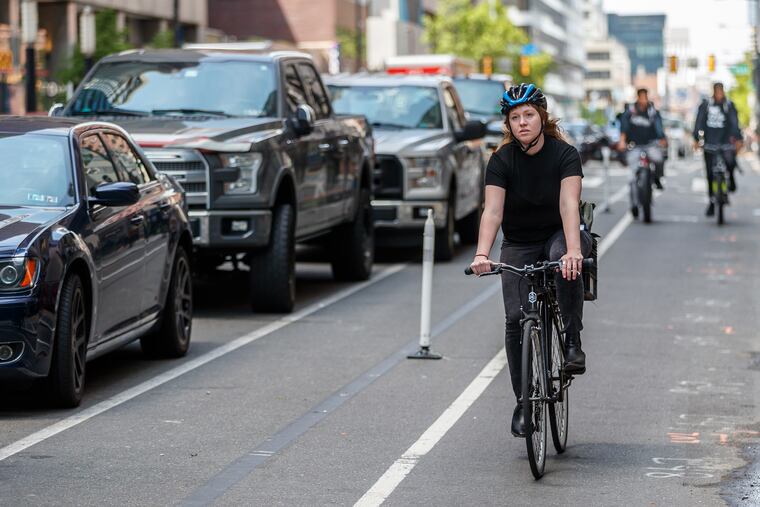Pennsylvania bill could bring more of safest bike lanes to Philadelphia
If made into law, the bill would allow bike lanes on Pennsylvania state roads to be separated from vehicle traffic by parked cars.

A bill under consideration in Harrisburg would make it possible for cities like Philadelphia to build one of the safest kinds of bike lanes on state roads.
Cyclists have been lobbying for parking-protected lanes, which have a row of street parking between vehicle traffic and the bike lane. These kinds of lanes are allowed now on city streets, but not state roads, which are among the busiest and most dangerous for bicyclists.
Philadelphia described changes in the bill as “important to calming traffic, creating safe spaces for people walking and biking, and creating high quality and economically competitive neighborhoods,” said Christopher Puchalsky, director of policy and special initiatives for Philadelphia’s Office of Transportation, Infrastructure and Sustainability.
A parking-protected bike lane can be eight to 10 feet wide, according to the Bicycle Coalition of Greater Philadelphia. The bicycle lane itself is typically about five feet wide, and a buffer of about three feet is painted on the pavement. Cars are allowed to park beyond that, meaning this kind of bike lane often results in a street losing a travel lane.
>>READ MORE: Safest bicycle lanes are those with physical barriers
Sen. Lawrence Farnese (D., Philadelphia), sponsor of the Senate version of the bill, said he proposed the legislation in part due to an increase in bicyclist deaths in Pennsylvania. The number of commuters who bike to work in Philadelphia has increased from 1.8 percent to 2.6 percent since 2010, according to recent U.S. Census data.
“I think it really, really helps everyone who’s living and working in these municipalities,” Farnese said.
PennDot is open to the change, spokesperson Erin Waters-Trasatt said.
“While standard bike lanes are permitted,” she said, “legislation that would allow the installation of parking-separated facilities continues to be one of the PennDOT’s legislative focus areas.”
Philadelphia already has parking-protected bike lanes on some city roads, perhaps most visibly on Market Street and John F. Kennedy Boulevard in Center City. Along with Philadelphia, Farnese said, Pittsburgh and York have been expanding their network of parking-protected lanes.
>>READ MORE: Bike lanes, speed cameras, and traffic enforcement: Philly City Council moves ahead on safe streets issues
The bill also would make it easier to build pedestrian plazas, which are carved out of excess roadway to create a traffic buffer for walking, particularly in commercial areas.
About 360 miles of Philadelphia’s 2,575 miles of roads are owned by PennDot. They make up a disproportionate percentage of the city’s most dangerous streets, though, according to the Bicycle Coalition. The organization, along with a sister organization in Pittsburgh, is lobbying for the bill.
“They’re the streets that need the most work,” said Randy LoBasso, spokesperson for the Philadelphia Bicycle Coalition. “If you don’t have these tools available, they will continue being high-injury streets.”
About 58 percent of the streets that the city has identified as the most likely to have serious injuries or deaths on them are state roads, LoBasso said.